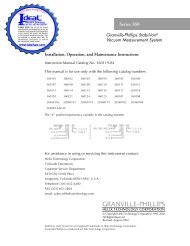Leybold D 2,5 E, D 2.5 E - Ideal Vacuum Products, LLC
Leybold D 2,5 E, D 2.5 E - Ideal Vacuum Products, LLC
Leybold D 2,5 E, D 2.5 E - Ideal Vacuum Products, LLC
You also want an ePaper? Increase the reach of your titles
YUMPU automatically turns print PDFs into web optimized ePapers that Google loves.
Key to FIg. 2<br />
1 Gas ballast valve<br />
2 Gas ballast inlet<br />
3 Tandem valve<br />
(vacuum protection)<br />
4 Intake pelft<br />
5 Oilleed (oil pump)<br />
6 Rotor<br />
7 Vane (HV)<br />
8 High vacuum stage<br />
(pump chamber)<br />
9 Vane (FV)<br />
10 Forevacuum stage<br />
(pump chamber)<br />
11 NOtHeturn valve<br />
12 Diaphragm valve<br />
13 Exhaust valve<br />
14 Bypass vatve<br />
I 5 Exhaust port<br />
Fig. 2 Sectional view Ihroogh a TRIVAC D 2,5 E pump<br />
By opening the gas ballast valve (211, optional) it is possible<br />
to admit a controlled quantity of air (gas ballast) into<br />
the pump chamber while the compression process is in<br />
progress. The gas ballast will preven't the condensation<br />
of vapours within the pump up to the extent of the vapour<br />
tolerance levels as stated in the specifications for the<br />
pump (these data refer to water vapour).<br />
A special lubrication system with forced lubrication of the<br />
sliding bearings has been developed to enable operation<br />
of the pump at intake pressures up to 1000 mbar.<br />
An oil pump supplies the oil from the oil reservoir into a<br />
high pressure oil system which in turn supplies all bearings.<br />
From here the oil enters the pump chamber of the<br />
vacuum pump.<br />
The oil pump is located in bearing piece of the high vacuum<br />
stage. Separation of oil and gas in the pump involves<br />
two stages. First an internal demister which is arranged<br />
ahead of the exhaust valve ensures the creation of larger<br />
droplets.<br />
Next these are returned back to the oil reservoir via a<br />
separation panel. This ensures a minimal loss of oil.<br />
GA 01.602/1 .02 . 03101<br />
11<br />
2<br />
3<br />
Description<br />
This and the combination with the large usable oil reser·<br />
voir, results in long intervals between the oil exchanges,<br />
even at high intake pressures.<br />
The gas ballast valve (GB) is opened or closed by turning<br />
it (positions 0, 1, 2, 3).<br />
Available as an option is a gas ballast valve having a<br />
knurled screw (see Fig. 11 on page 26). When fully<br />
opening this valve, the resulting gas flow will correspond<br />
to that of valve position 3 in the following Table.<br />
GB position Explanation<br />
o no gas ballast<br />
maximum ultimate pressure<br />
1 for cleaning the pump's oil at a good ulti·<br />
mate pressure and low oil consumption<br />
2 good water vapour tolerance·<br />
without producing excessive noise<br />
3 maximum water vapour tolerance in<br />
accordance with the technical data on<br />
page 6.<br />
5<br />
7

















